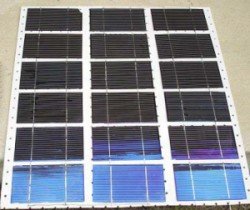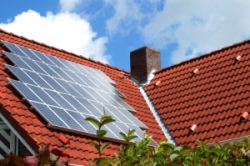Solar Electricity For Your Home
Imagine using the power of the Sun to generate your own residential solar electricity!
Home solar power systems can help you...
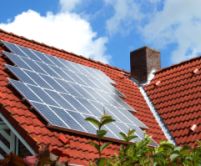
- Save money by reducing or eliminating your monthly electrical bill
- Become less dependent on your utility company
- Make a positive impact on the earth
For homeowners, this can all be accomplished by installing a photovoltaic solar power system.
![]()
Solar Electricity Topics...
What is a PV Solar Power System?
A PV system converts solar energy into solar electricity for use by electrical devices in your home. It is made up of three subsystems.
- PV Devices
- Load
- Balance of System (BOS)
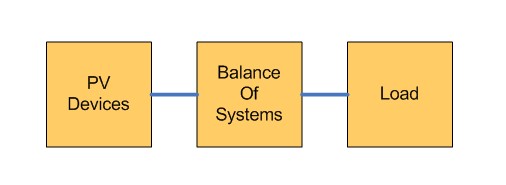 PV Solar Power System Diagram
PV Solar Power System DiagramThe PV Devices generate the solar power by converting sunlight into direct-current (DC) electricity.
The Load is simply the device that uses the electricity. Your refrigerator is a good example of a load.
The BOS consists of all the equipment between the PV devices and the load. It includes the structures for mounting the PV devices, the power conditioning equipment to convert the DC electricity to alternating-current (AC) for use by the load, and batteries for storing the PV generated electricity if desired.
If you want to learn more, check out Solar Electricity Basics.
PV Devices
The solar cell is the basic building block of a PV system. It converts solar energy directly into electricity through a process known as the photovoltaic effect.
An individual solar cell doesn't generate much power. The amount varies, but it is around 1 or 2 watts. But you can increase the solar power generated by joining them together into a larger unit called a PV module. PV modules are also known as solar power panels. The power output of a PV module ranges from 10 watts to 300 watts. To generate even more power, PV modules can be combined to form a PV array.
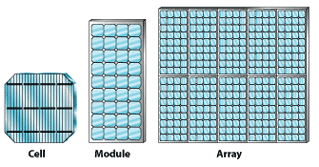 PV Cell, Module, and Array
PV Cell, Module, and ArrayA PV array can consist of any number of modules. This modularity makes photovoltaic systems very flexible. They are able to meet any electrical requirement, whether the amount of power needed is small or large.
But to take advantage of the electricity produced by a PV array, you need a few more components...
Balance of System (BOS)
The BOS components enable the solar electricity to be properly applied to the load.
- Mounting Structures: The mounting systems needed to integrate your PV array with your home's structural systems.
- Array DC Disconnect: Stops the flow of electricity from the PV array. Essential for system maintenance and troubleshooting.
- Charge Controller: Monitors the battery bank to prevent it from being overcharged.
- Battery Bank: A group of batteries wired together that store the energy produced by the PV array for later use.
- System Meter: Allows you to monitor the performance and status of your PV system.
- Main DC Disconnect: Stops the flow of electricity from the battery bank to the inverter.
- Solar Power Inverter: PV arrays produce direct current (DC) power. The inverter converts the DC power into the standard alternating current (AC) power used in your home.
- AC Breaker Panel: This is the same breaker panel you already have in your house. This is where the power from your PV array and the utility are routed to your home's electrical system.
- Electric Meter: Measures the amount of electricity supplied to or produced by your home. The utility uses it to calculate your monthly electricity bill.
- Backup Generator: Produces AC power that is converted to DC power by the inverter for storage in the battery bank. Used when the PV devices aren't able to produce electricity for prolonged periods of time.
The exact BOS components you need will depend on the type of PV system you install.
Types of PV Systems
The three most common types of photovoltaic systems for residential solar power are...
Grid Tied PV System
A grid-tied PV system allows you to use the electricity generated by your PV system as well as electricity from the grid. When your PV system is producing electricity, your home will be powered by solar electricity. During the times when your PV system isn't producing electricity, such as at night, your home will receive power from the grid.
Any excess electricity produced by your system can be fed back to the grid. This is known as net-metering. With net-metering, when you use electricity from the grid your meter spins forward and when you are providing electricity to the grid your meter spins backwards. This offset means you are actually receiving market rates for the electricity you provide to the grid!
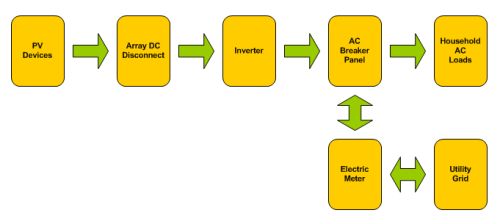 Grid Tied PV System Diagram
Grid Tied PV System DiagramFor most people, a grid-tied PV system is the ideal configuration.
You get all the benefits of using your own solar electricity as well as the benefits of being connected to the grid. It is also less expensive than other types of PV systems.
Grid Tied PV System With Battery Backup
A grid-tied PV system can also be supplemented with a battery backup.
Why would you need a battery backup since you are connected to the grid?
Well, grid-tied PV system inverters are designed to shut down when the grid experiences a power outage in order to protect the utility repair workers from being shocked by electricity coming from your PV array. As a result, during a power outage, you won't be able to utilize the electricity coming from your PV array.
However, if your PV system includes a battery bank, during a power outage you can utilize the energy that your PV system produced and stored in the batteries.
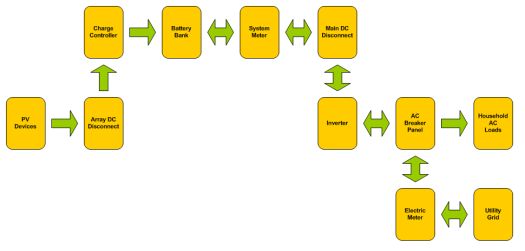 Grid Tied PV System With Battery Backup Diagram
Grid Tied PV System With Battery Backup DiagramA grid-tied PV system with battery backup is ideal if you live in an area that has unreliable power from the grid or that experiences power outages due to natural disasters.
Stand Alone PV System
Stand-alone PV systems are designed to operate independently from the grid and to provide all of the electricity you need for your home.
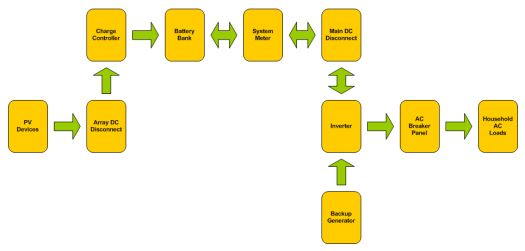 Stand Alone PV System Diagram
Stand Alone PV System DiagramIf you have a home that is in a remote area that doesn't have utility grid service or where it would be very costly to have power lines run to your home, a stand-alone PV system would be ideal.
This type of PV system is also desirable if you are looking to go completely green with your source of electricity.
Solar Electricity Your Way!
As you can see, home solar power systems give you a flexible way to harness power from the sun to generate your own pollution-free, cost-saving solar electricity!
Home > Solar Electricity
